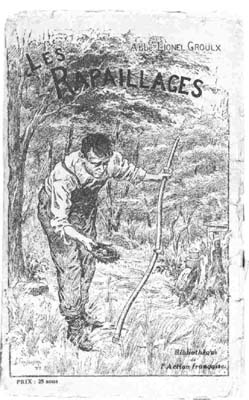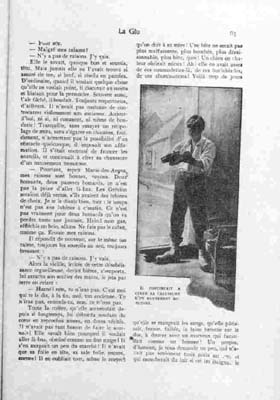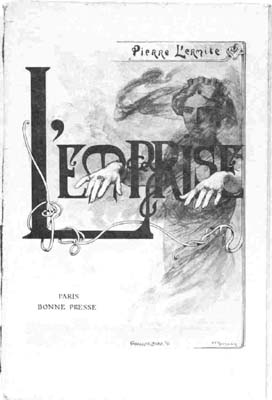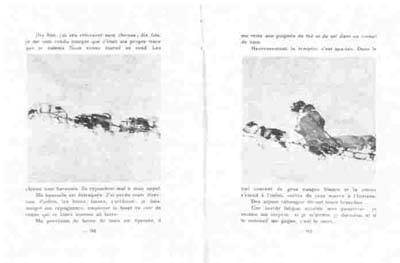
Annual Bulletin 3, 1979-1980
Home
Français
Introduction
History
Annual Index
Author &
Subject
Credits
Contact





A
Selection of Books Illustrated by
Quebec Artists between 1916 and 1946
by Jean-René Ostiguy
Pages 1 | 2
| 3
| 4
| 5
The Training of Quebec Illustrators
A large number of Quebec artists began doing illustration while working for newspapers
and magazines. Many of them had acquired experience in drawing and engraving
at the School of the Art Association of Montreal, which as early as 1903
had organized an exhibitions devoted to the members of an association of
artists employed by the best-known newspapers.
In the field of book illustration as such, however, the
first works to capture critical attention were done by artists for whom
illustration was a secondary activity. Subsequently, as one can well imagine,
the teachers of decorative composition or engraving at the École des
Beaux-Arts - which opened in Quebec City in 1920, or in Montreal (9) in 1923 -
did not fail to point out to their pupils the possibility of finding
employment in the publishing industry, especially since these schools were created
at a time when the renewal of the illustrated book was reaching its culmination
in Europe. In fact, the catalogue (10) of the Premier Grand Salon des
Anciens des Beaux-Arts de Montréal mentions an exhibition of French
books containing 30,000 volumes; the exhibition seems to have been organized
by the school in 1925 with the assistance of the Déom, Méthot
and Pony bookstores. Ten years later a newspaper article (11) reported the
opening of an important exhibition on the French-Canadian art of book-binding,
at the Montreal Library. Also discussed were the illustrated book and the
contribution of the teachers and students of the school toward it.
Apart from the educational context, a large number of artists
became interested in the resurgence of woodblock printing in Europe, and
so discovered the effect this had had in the book industry. In a letter (12)
to his brother-in-law Ernest Rolland in 1923, Adrien Hébert
showed himself to be a great admirer of Raphaël Drouart. Hébert
had, no doubt, been acquainted from some years with the illustrations of
this artist, who was discussed in the magazine Art et Décoration
in 1921 in an article by Raymond Escholier. (13) Adrien Hébert
as well as his brother Henri are both known to have subscribed to this
magazine, which they read assiduously. And when he wrote this letter,
Hébert knew that he was going to have to make eight woodblock prints
to illustrate some Canadian short stories for publication by Editions
du monde nouveau when he returned to Montreal. (14)
Rodolphe Duguay began to do woodblock printing in 1925 with
the aid of manuals by Maurice Busset (15) and Morin-Jean. (16) At that time he
became friends with his compatriot Louis-Phillipe Beaudoin, a student at
the École Estienne in Paris, and with him he visited the shops of professional
engraver-illustrators.
Finally, just before returning to Canada in 1927 he acquired
Charles Saunier's recent book Les Décorateurs du livre. (17) Similarly,
Edwin Holgate became interested in woodblock
printing in Paris in 1921. He acquired a work done by an acquaintance,
the young German engraver Fride Miller. Three years later he took part
in a woodblock printing exhibition at the Art Association of Montreal
with Yvan Jobin and Maurice Lebel. Shortly thereafter, having undoubtedly
done a fair amount of reading (18) on the subject, Holgate taught woodblock
printing at the École des Beaux-Arts de Montréal.
From these reference points one can gain a fairly clear
idea of how there came to be established in Quebec a tradition of woodblock
printing that contributed greatly to the resurgence of fine illustrated
books.
A Stroll Through the Garden of Illustrated Books in Quebec
Let it be borne in mind that the successes of illustrated books in
Quebec early in the twentieth century owed nothing at an to woodblock printing.
Louis Hémon's Maria Chapdelaine, illustrated by Suzor-Coté
in 1916, contains only reproductions of charcoal drawings (fig 1), as
does Les Rapaillages of Lionel Groulx for which Joseph-Charles Franchère
produced a cover (fig 2) and eleven hors-texte plates in 1919. La
Campagne canadienne by Adélard Dugré, illustrated by
Ozias Leduc in 1927, falls into the same category, with the notable difference
that the drawings are integrated into the text. As did the publishers of
Lionel Groulx's book in printing the drawing on the cover page (fig. 2),
Leduc often omitted one side of the frame in order to lighten his compositions
(fig. 3). As the French artist Laurent Desrousseaux (1862-1906) liked to
do in his illustrations (fig 4) for Jean Richepin's
La Glu (Modern-Bibliothèque, 1905), Leduc included the explanatory legends in
the pictures. Sometimes he invented highly fanciful shapes and border lines,
examples of which are also found in the work of Henri Emilien Rousseau
(1875-1965), another Parisian illustrator. The cover (fig. 5) for Pierre
L'ermite's L'Emprise (Bonne Presse, 1926) is a striking example
of European works in this genre. Moreover, Le manoir hanté,
a short novel by Régis Roy, published in 1928 and illustrated by Jean Paul Lemieux,
as well as Louis F. Rouquette's Le grand silence blanc, illustrated
by Clarence Gagnon - which received much more attention - remotely suggest
the influence of woodblock.
The case of Jean Paul Lemieux is a unique one for a number
of reasons. While the artist benefited from Holgate's teaching and friendship,
he was never interested in engraving. He met Clarence Gagnon at a time
when this master was working almost exclusively on projects for illustrations,
and he too planned to pursue a career in illustration. Unfortunately,
Lemieux very soon abandoned this idea because he was not receiving orders
regularly. Nevertheless some of his works should be mentioned, including
his illustration for Le manoir hanté, published in Montreal
by Louis Carrier in the Les Cahiers populaires series. In this novel the
frontispiece and the seven drawings (fig. 6) appear to be in close harmony
with the spirit of the text. They are greatly stylized and could lead one
to believe that the artist was an admirer of Émile Heaume (who had
been supplying occasional woodblock prints and drawings to various French publishers since
the twenties). Certain drawings (fig 7) for André Maurois's
Niange ni bête reveal similarities between the two artists.
Clarence Gagnon doubtless earned the title of Quebec's
first decorator of modern books with his illustrations for
Le grand silence blanc (fig. 8), published in Paris by Mornay. For this work
Gagnon used a procedure that was uncommon in France in book illustration
as such, namely silk-screen printing (19) from monotypes executed in gouache.
It is not known how he arrived at this procedure; what is known
is that he had been an expert etcher twenty years earlier, when he was
in pursuit of an esthetic that associated hill more closely with the Canadian
painter Horatio Walker. Subsequently, the examples of James Wilson Morrice
and Camille Maufra or Charles Cottet led him in a new direction, as did
his contact with the Canadian artists and their milieu. From 1925 onward,
the influence of the famous French illustrator and animal painter, Henri
Deluermoz, led Gagnon conclusively to a new formal expression similar
to what Mornay (the publisher) was looking for. In a curious reversal
of influence, Deluermoz was to collaborate with L. J. Soulas in illustrating
J. O. Curwood's Nomades du Nord (Mornay, 1932) and would have no
qualms about borrowing Gagnon's method of treating northern subjects (fig
9).
Next Page | Le
grand silence blanc
1 | 2
| 3
| 4
| 5
Annual Index | Author & Subject | Credits | Contact
This digital collection
was produced under contract to Canada's Digital Collections program,
Industry Canada.
"Digital
Collections Program, Copyright
© National Gallery of
Canada 2001"